A jury of 50 North American auto writers voted the redesigned Hyundai Elantra the most significant new car of 2021. It received more votes for than the other two finalists, the Genesis G80 and the Nissan Sentra, and than semi-finalists that included the Acura TLX, Cadillac CTS-4, Kia K5, Mercedes-Benz E-Class, and Polestar 2. I personally did not expect this; I thought the G80 would win. What is so amazing about the seventh-generation Elantra? How is it a major improvement over the previous Elantra and the related Kia Forte? I spent a week with an Elantra Limited to find out.
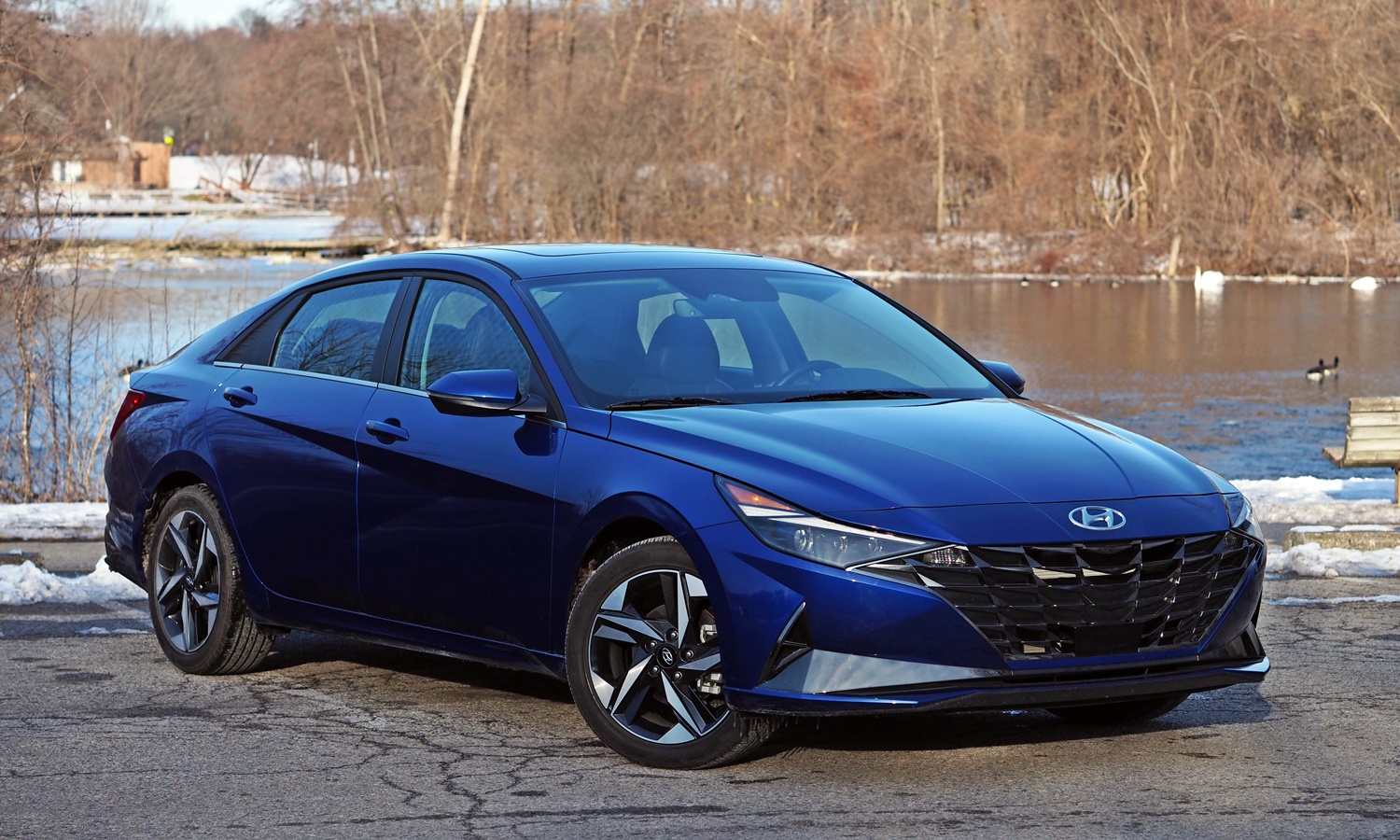
The odd downward angled character line isn't visible in this shot. Rear pillar still doesn't work. more Elantra photos
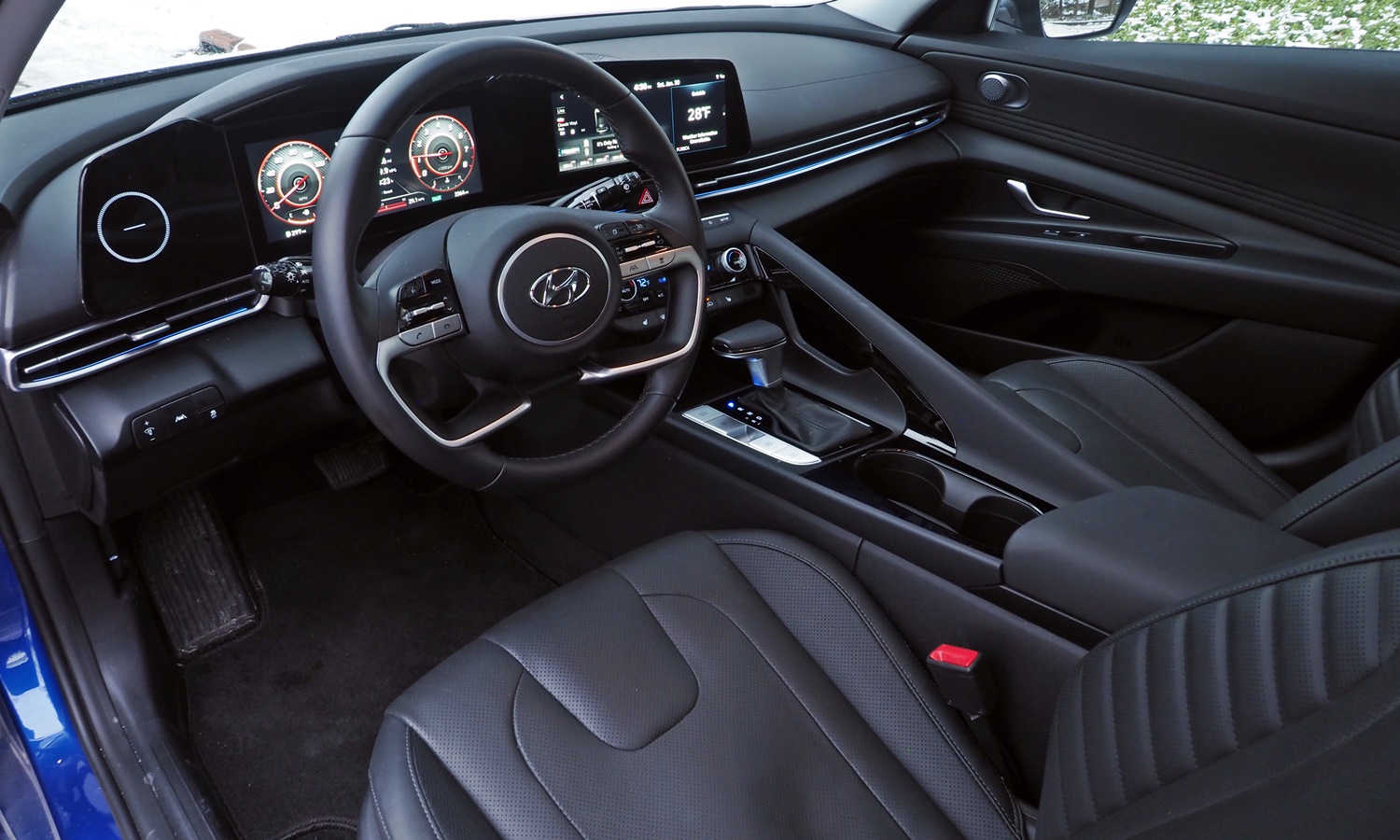
The interior styling, though not the interior materials, of an upscale car.
| |
Compared to the Forte |
| Interior styling |
 Better
Worse
Better
Worse
|
The new Hyundai Elantra most impressed me with its upscale interior design. Most notably, the reconfigurable LCDs for the instrument cluster and infotainment interface are styled to look like they're both part of a single continuous panel like those in recent Mercedes. Hyundai couldn't figure out what to do with all the real estate--a white circle that does nothing at all fills the space to the left of the instrument cluster.
The LCD instruments standard on the Limited and optional on the SEL automatically change their appearance based on which driving mode you're in. You can also manually select the mode. (Check these out in the full photo gallery.)
Many people don't like a center stack display that sticks up above the instrument panel and appears tacked on. Interestingly, when this freestanding form continues across the instrument panel to include the instrument cluster, it no longer appears tacked on, at least not to me.
Other interior details also have been cribbed from upscale German sedans, though most don't look or feel as expensive when subjected to more than a passing glance. Hyundai hasn't worked any miracles in the cost department, so there's a lot of hard plastic. You'll find a more upscale ambiance inside a Mazda3. But the 2021 Elantra's interior does look much more stylish and upscale than that in the previous Elantra, with the Forte failing closer to the latter than the former.
| Front seat support & comfort |
 Better
Worse
Better
Worse
|
Though adjustments to their shape are limited to power lumbar, the new Hyundai Elantra's well-bolstered front seats fit me especially well. Your size and shape likely differ from mine, so impressions of seat comfort will vary. Whether they fit or not, in the Elantra Limited (unlike in the Forte) they are upholstered in real leather and would not appear out of place in an Audi.
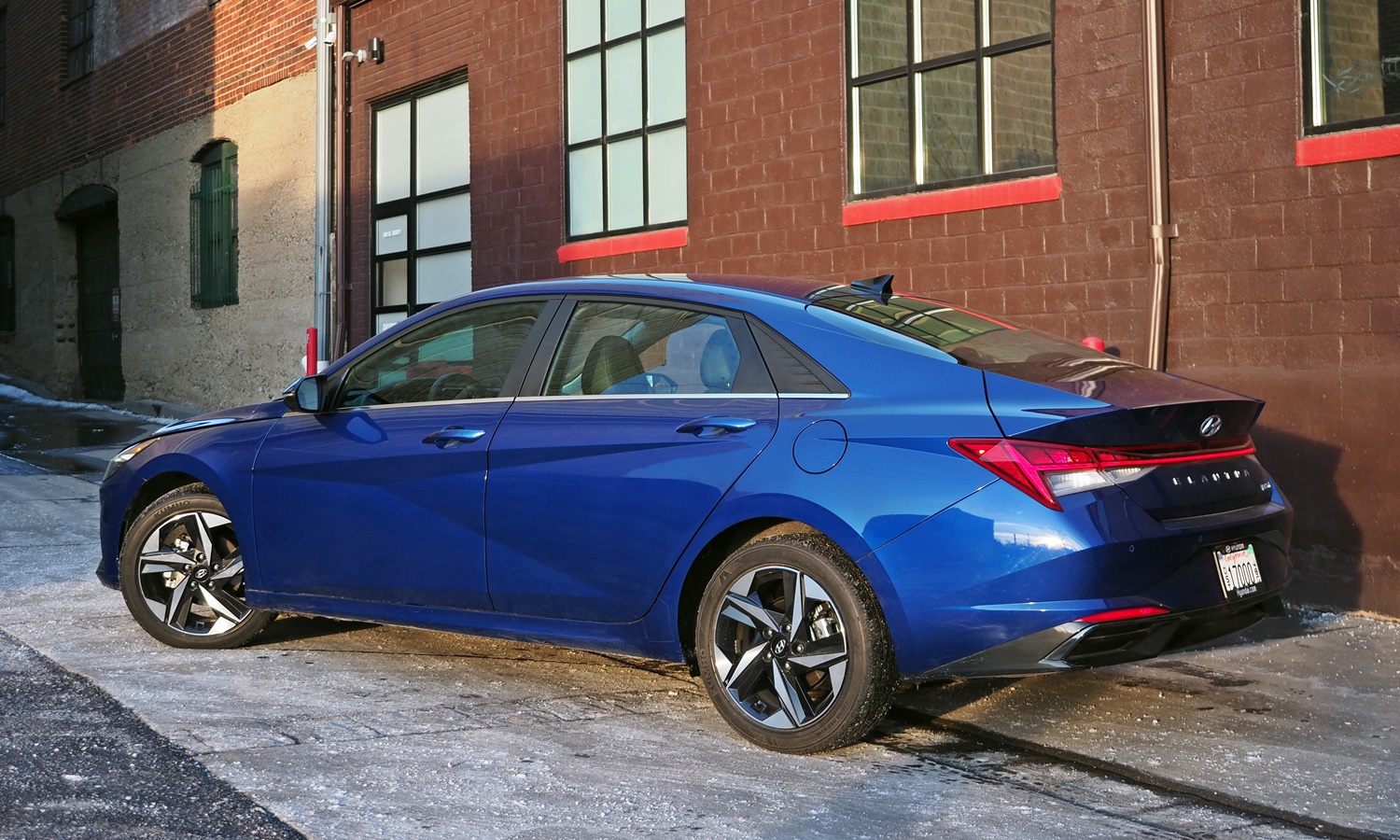
I can't quite explain why the rear pillar doesn't work. Black plastic trim too pointy?

LCDs for instruments and infotainment styled to look like a single unit, as on recent Mercedes.
| Price or payments |
 Better
Worse
Better
Worse
|
Typical of a Hyundai, the Elantra is less expensive than a similarly equipped Honda Civic. The tested top-of-the-line, fully equipped 2021 Elantra Limited listed for $26,610. The 2022 will run $150 more. A similarly contented 2022 Honda Civic Touring lists for $29,315. You get a more powerful engine, larger wheels, and a power passenger seat on the Honda, but are these worth $2,500 to you?
In the other direction, a Kia Forte EX lists for just $24,240, but lacks the Hyundai's leather seating surfaces, adaptive cruise control, rear obstacle detection, LED headlamps, and auto-dimming headlamps. In its favor, the Kia does have ventilated front seats. Are the Elantra Limited's additional features worth $2,360? For some people yes, for others no. Either car is a strong value.
These are the top trims with the 2.0-liter engine. The ranges start much lower: $20,665 for the Elantra, $18,885 for the Forte (which has a lower level of standard equipment), and $22,245 for the Civic.
Both the Elantra and the Forte include a longer standard warranty than competitors: 5/60 basic and (for the first owner) 10/100 powertrain, so they should also cost less to own down the road.
| Fuel economy |
 Better
Worse
Better
Worse
|
With EPA ratings of 31 mpg city and 41 mpg highway, the Hyundai Elantra Limited with a 2.0-liter engine and CVT is among the most fuel-efficient non-hybrid compact sedans. Lesser trim levels score even better: 33 city, 43 highway. Though the Kia Forte has the same powertrain, it scores a couple mpg lower.
For even better fuel economy, the Elantra is offered as a hybrid with EPA ratings as high as 53 mpg city, 56 mpg highway, and 54 mpg combined. The Honda Insight and Toyota Corolla Hybrid manage only 52 mpg combined. One trim of the Prius (a hatchback) manages 56, but the others check in at 52.
In my winter suburban driving I observed trip computer averages between 30 mpg and 40 mpg.
| Safety & braking |
 Better
Worse
Better
Worse
|
With an increasing number of manufacturers making a suite of safety technologies standard on their cars, it has become harder to clearly outrank competitors in safety. Still, Hyundai has. Even the least expensive Elantra comes standard with forward collision warning and avoidance, blind spot warning and collision avoidance, rear cross-traffic warning and collision avoidance, lane keeping assist (which effectively keeps the car centered in the lane on staight roads and through gentle curves), and automatic high-beam headlights. Blind spot warning is especially uncommon on base trim cars. Higher trim levels add adaptive cruise control that can remain engaged in stop-and-go traffic and rear obstacle detection with collision avoidance. The Limited additionally includes Highway Driving Assist, which uses navigation system information to enhance the performance of the adaptive cruise and lane keeping assist systems on certain highways.
The Forte offers most of the same warning systems, but some of them lack the additional ability to intervene and try to prevent a collision and blind sport warning is not offered on the base trim.
In addition to all of this tech, the new Elantra earned good scores in all of the IIHS's crash tests.
| |
Compared to the Forte |
| Exterior styling |
 Better
Worse
Better
Worse
|
While I admire Hyundai's attempt to do something different with the new Elantra's exterior styling, and I can see where they were trying to go with the jarringly straight character lines that carve the mark of Zorro in the faceted body sides, the result doesn't work for me. Maybe the point at which the lines intersect isn't in the right spot. Or maybe it's just that such straight lines conflct with the sedan's curvy fenders and roof line. A similar theme works much better on the upcoming Ioniq 5 EV, which has a much squarer profile (see full photo gallery).
Beyond these character lines, I'm never a fan of a triangle of black plastic trim trying to pass for a window on the rear pillar. But the Elantra's triangle has a series of hash marks molded into it, so it's not really trying to pass for glass, making it better than most. That area of the exterior still doesn't look right; maybe if that black plastic trim had a kinked rearward corner rather than coming to a point. As it is, the rear quarters appear insubstantial. I have the same issue with the styling of the late, not much lamented Lincoln MKZ, which had a real window in that pillar.
Or maybe it's a lack of muscle in both the front and rear fenders. The current (and perhaps last) Chevrolet Malibu similarly appears weak.
As has become fashionable, the new Elantra has a huge grille. This grille looks better than most--it's my favorite part of the exterior design--but suggests far more than 147 horsepower. Then again, the new N performance model has 276 horsepower. No false promises with that Elantra variant. Ultimately, even with the big fancy grille the new Elantra lacks presence. Though aspects of the design attempt an upscale character, the overall look doesn't get there.
| Front seat room |
 Better
Worse
Better
Worse
|
Due to a flying buttress / grab handle that slices downward from the instrument panel to the center console, the front passenger might feel overly constricted. If that passenger is in an N with a highly enthusiastic driver, the grab handle might be welcome. But in Elantras with the 147-horsepower engine it's just silly. It also looks and feels like the hard plastic it is.
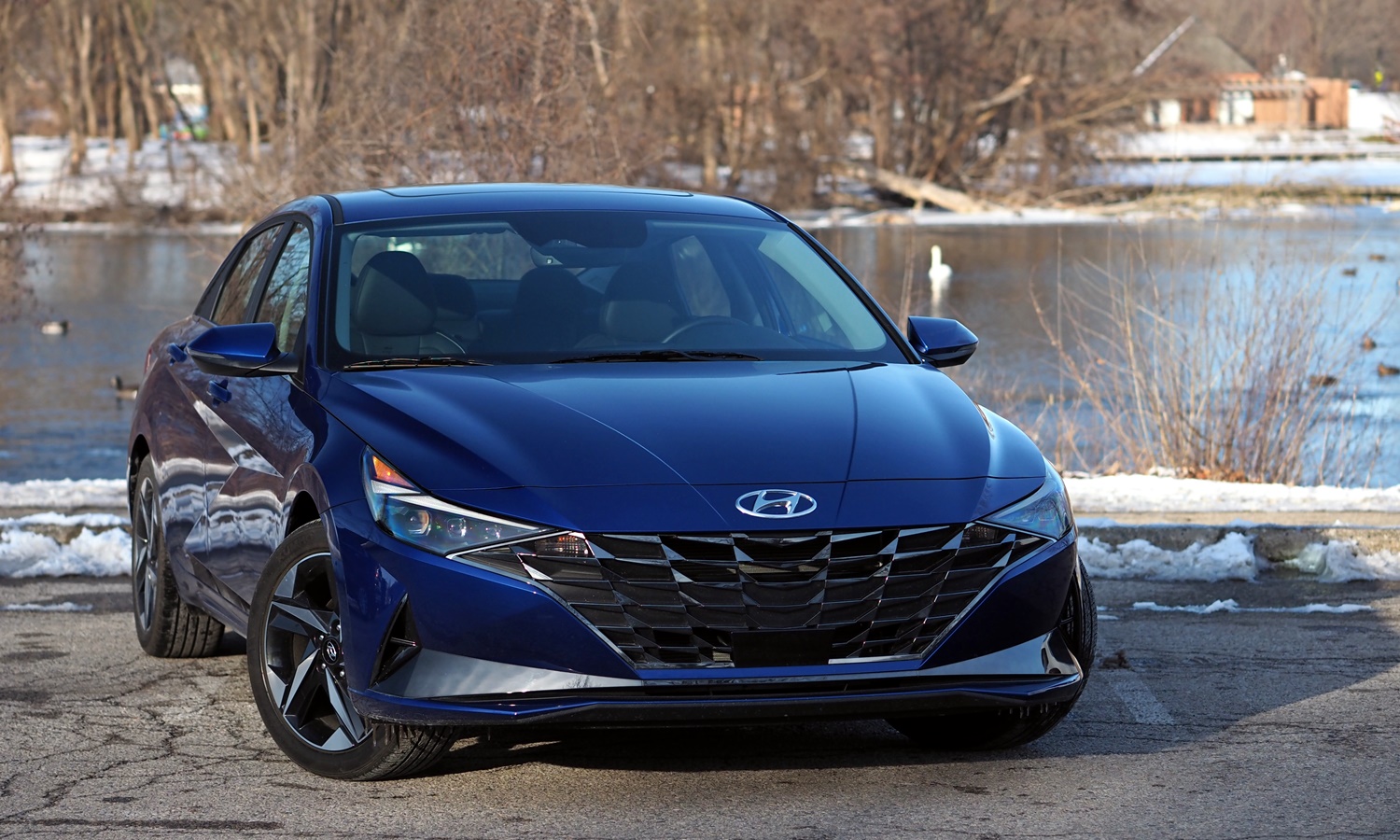
Big fancy grille for such an inexpensive compact sedan.
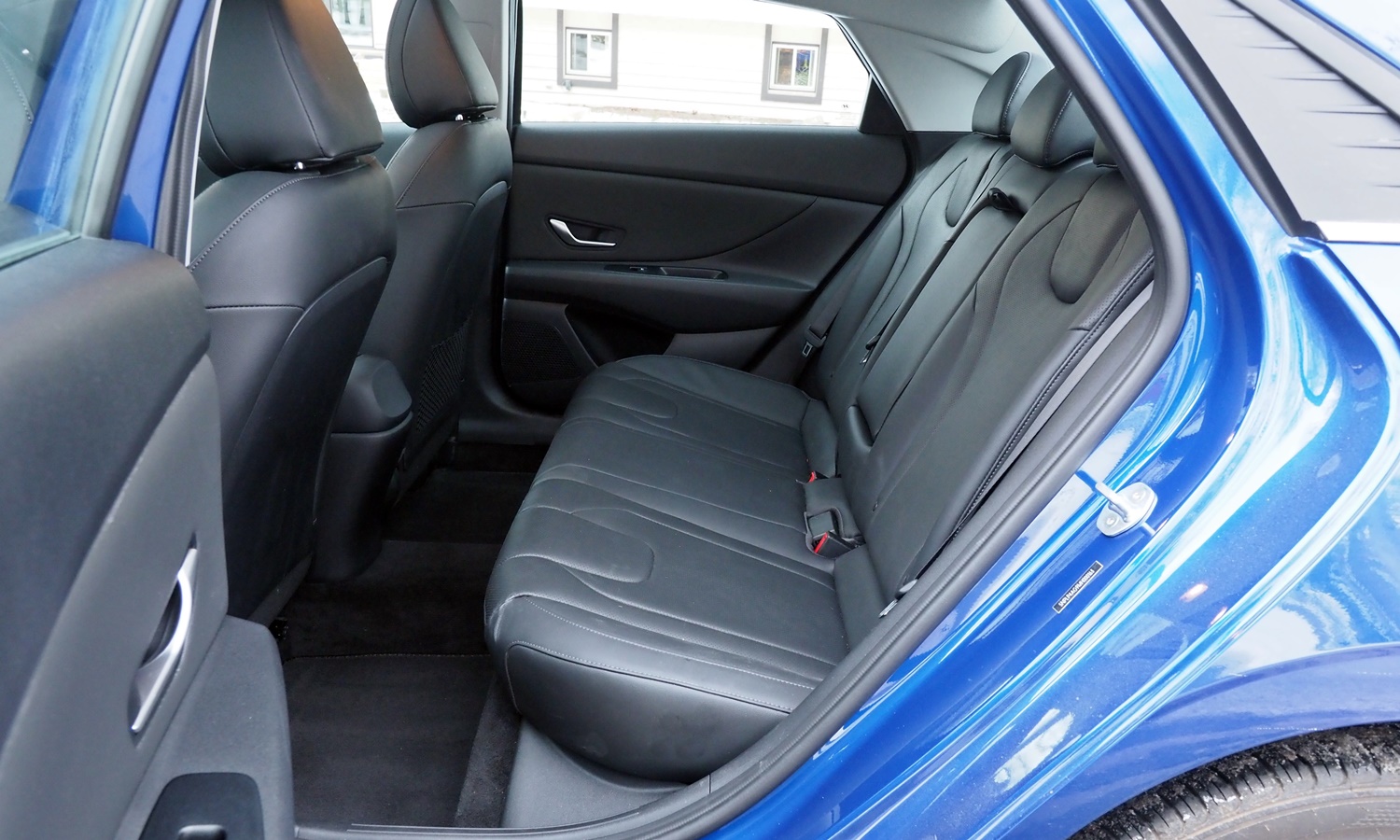
Abundant legroom, marginal headroom.
| Rear seat room & comfort |
 Better
Worse
Better
Worse
|
Rear seat passengers enjoy abundant knee room, but those of more than middling height will find headroom and thigh support marginal at best. These weaknesses are fairly common in current compact sedans, but the Forte, with a taller, less swoopy roof line, has a more comfortably positioned rear seat and a bit more rear headroom.
| Powertrain performance |
 Better
Worse
Better
Worse
|
Performance from the 147-horsepower 2.0-liter four-cylinder engine and CVT is just adequate, and the engine can sound buzzy when hustled. The Kia Forte uses the same powertrain, so it performs no better, but you'll find considerably better performance in the top-trim Honda Civic and in any Mazda3.
For more power and sportier suspension tuning, check out the Elantra N Line with a 201-horsepower turbocharged 1.6-liter engine and either a six-speed manual or a seven-speed DCT. I reviewed the previous iteration, the 2017 Elantra Sport. For serious thrills, Hyundai will soon offer the 276-horsepower Elantra N. I reviewed the Veloster N with the same powertrain here.
| |
Compared to the Forte |
| Handling |
 Better
Worse
Better
Worse
|
In Limited trim, the Elantra never feels sporty, but it generally feels composed and competent. Hyundai claims that the 2021's new, more rigid platform affords more precise handling than the old platform used for the previous Elantra and the current Forte. I suspect that driving the cars back-to-back would verify this.
In the default mode the steering can feel overly light. Sport mode tightens it up a bit, but also makes the CVT programming overly aggressive. To get firmer steering without frenetic drivetrain behavior, select sport mode then manually shift the CVT to select one of eight fixed ratios. When you do, you'll discover that the shifter (still mechanical) has a solid, quality feel to it that has often evaded those in affordable cars.
| Ride smoothness |
 Better
Worse
Better
Worse
|
Unlike the previous generation, the new Hyundai Elantra rides smoothly for a compact sedan. In Limited trim it struck me as a refined transportation appliance. My sense is that some other current compact sedans feel are about as smooth and quiet, but the Elantra could be at or near best-in-class in this area. Given some back-to-back comparison drives I might list this as a reason to buy the Elantra.
The Hyundai Elantra's 14-cubic-foot trunk that can be expanded by folding the rear seat is roughly par for the class, splitting the difference between the one-cube-tighter Corolla and the one-cube-larger Forte.
What I personally mind is that, unlike those and some other competitors, the new Elantra is only offered as a sedan. The Elantra GT hatchback did not sell well and is no more.
So, how did the new, seventh-generation Hyundai Elantra win this year's NACOTY award? The answer isn't blindingly obvious. The 2021 Elantra performs better than average in most areas, including overall refinement and standard safety tech, but doesn't dramatically raise the bar. The exterior styling is bold and distinctive, but doesn't quite work. Could it have been the aspect of the car that wowed me the most, the Mercedes-inspired instrument panel? That likely assisted.
Fuel economy is also part of the winning formula. The tested 2.0-liter Elantra scores about as well as any non-hybrid in the EPA's tests, and the new Elantra Hybrid scores higher than any other sedan without a plug.
Finally, some jurors noted the breadth of the Elantra range. You can get a relatively inexpensive car with a long warranty that does just about everything well in standard, hybrid, somewhat luxurious, sporty, and high-performance forms. Seeing how Detroit has abandoned the compact sedan class, the jurors might have wanted to reward Hyundai for heading in the opposite direction.

Adequate performance, very good fuel economy.
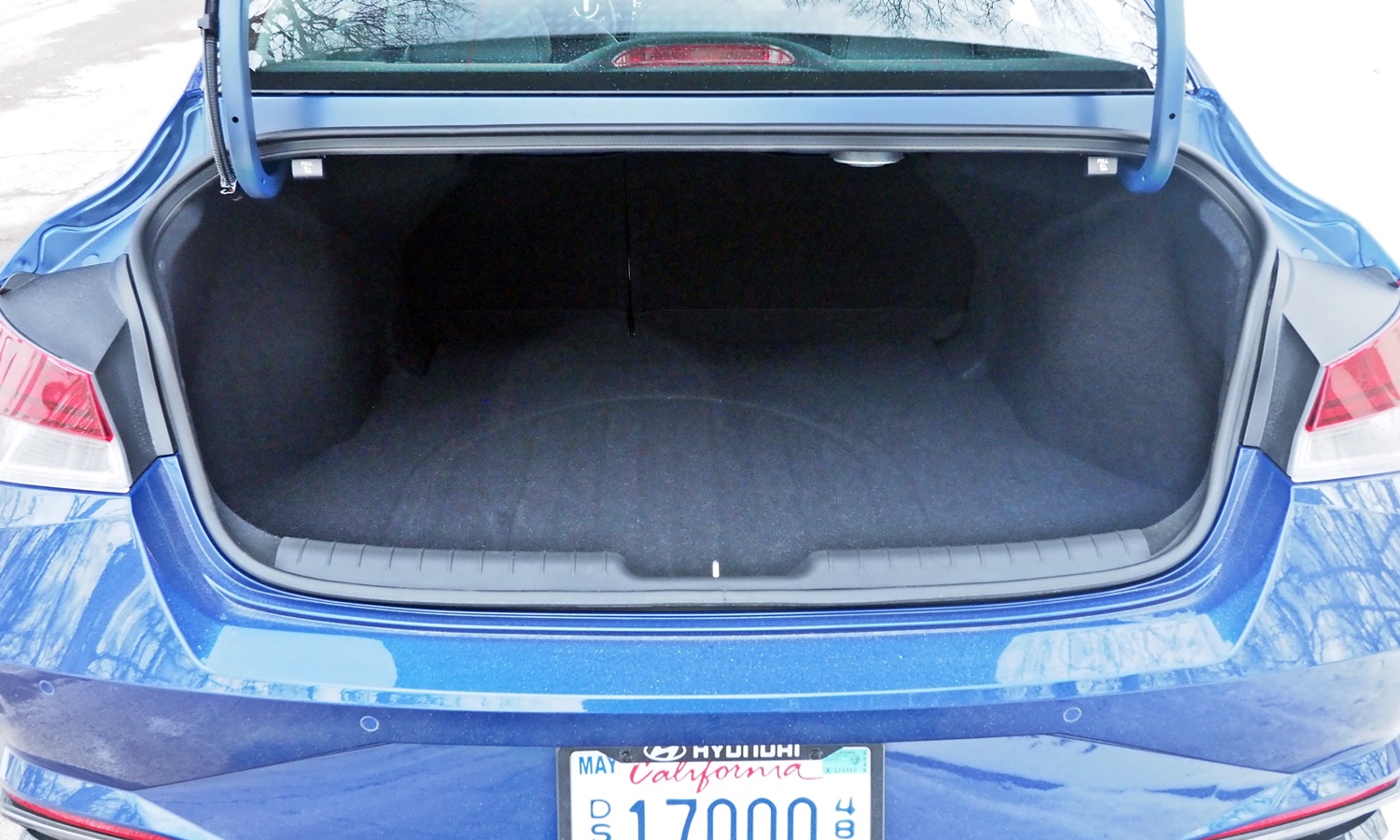
About average trunk space.
See more 2021 Hyundai Elantra photos
Hyundai and Kia each provided an insured car for a week with a tank of gas.











